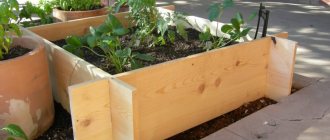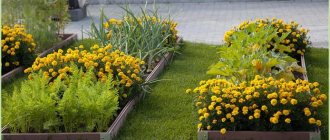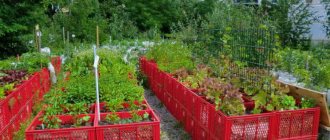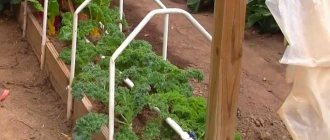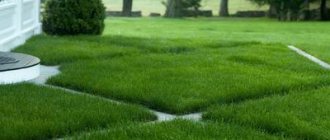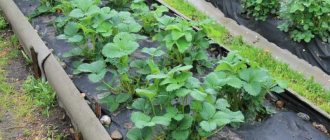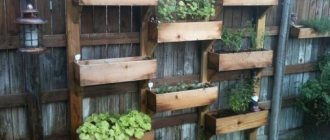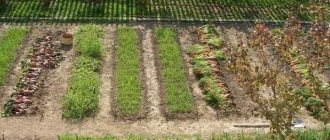The dacha often becomes a place where it is necessary to work exhaustingly. Every trip out of town becomes hard labor. Weeds grow at a breakneck speed, plants dry out from lack of moisture, and the soil needs to be loosened every time. Do-it-yourself smart beds in the country will be a real salvation in this situation. This technology makes it possible to reduce the cultivated area of the garden by several times and reduce the amount of water used for irrigation. Finally, there is some time to relax. Below you can see photos of homemade smart beds on your site and how to build them.
What is a smart garden and how is it different from a regular one?
Smart vegetable garden - high beds, which are often called warm or compost. The use of such structures eliminates the need to dig up the soil every season. With minimal labor costs you can get maximum yield. However, for this it is extremely important:
- plan plantings correctly;
- take into account the turnover of planted crops;
- apply various growing technologies;
- take care of mulching the ground or use covering material;
- Use drip irrigation to moisten the soil.
Metal border
In order to make a metal box you will need sheets, screws and corners. It is better to use galvanized steel, which will last longer.
- plus: strong, reliable fencing;
- minus: in summer, under the influence of the sun, the metal heats up and damages the root system of plants. The metal is susceptible to corrosion. It needs to be repainted periodically.
Metal beds
Advantages and disadvantages
The raised layer of smart beds allows you to isolate them from the soil layer. Each site owner can make simple box-shaped structures with his own hands, using available materials.
Among the main advantages of warm (smart) garden beds it is worth highlighting:
- Possibility of independent choice of shape, shade, coating and general design of structures. If you wish, you can create amazing compositions that will transform your garden.
- With the correct organization of sowing technology, you can achieve 2 harvests in one season.
- If the bed is properly maintained, the soil will be maximally saturated with mineral elements.
- The raised design makes it easy to care for vegetables.
- Reducing time for caring for the garden.
The disadvantages of smart beds are:
- Inappropriate and even unprofitable use in regions with arid climates.
- The need for systematic fertilizing. Raised soil requires frequent fertilization of the soil, which will make it possible to obtain a hefty harvest.
- Increased risk of developing unfavorable microclimatic conditions at the bacterial level compared to ordinary soil.
- It is impossible to grow spinach, lettuce, and beets in raised beds. The listed plants die in such conditions. This is explained by the discomfort that cold-resistant crops experience in well-warmed soil.
Such beds can significantly transform the site
The main task of this technology is to make sure that working in the dacha is not a burden. This is possible if you approach the organization of the process wisely. And it’s completely in vain that this technology is called “a garden for the lazy.” At the stage of arrangement you will have to work hard, but then everything will grow almost on its own, but the first stage requires hard efforts.
It’s worth starting with site planning. It is necessary to choose the location of the beds taking into account the lighting. Then develop a scheme for laying water pipes along the section and lay them. At the same time, you can build beds. Roughly in that order. All this requires time, significant effort and money. Material costs may not be too large.
Beautiful garden beds at the dacha with your own hands: photos and design recommendations
A garden bed is a relatively isolated area of soil where plants of a particular species are grown. Summer residents grow many crops that have similar cultivation characteristics or, conversely, contradict each other. By zoning a site using beds, you can separate incompatible plant species or combine those that have the same care system.
Properly selected raised beds will rid paths of excess soil and dirt.
Vegetable crops, like flowers, need certain conditions. The shape and size of the bed can affect the degree of soil moisture and the intensity of gas exchange processes. Even the species diversity of microorganisms that will live in the upper layer of soil depends on the type of structure. In addition, it is important to know how to properly place the beds on the site. Photos of unusual beds from this article confirm that the design of a site can be both decorative and practical. At the same time, you can create not just beautiful plantings, but also get a harvest from them.
Small beds with aromatic herbs and seasonings can be conveniently placed near the summer kitchen on the site.
Note! Despite the same purpose of the beds, do not forget that some plants require a certain soil composition. However, other crops may be less demanding. The same goes for soil consistency, light conditions and humidity. Inattention to such nuances can lead to reduced yield or loss.
You can build a special box for a warm bed yourself or purchase it at a garden center.
Planning a vegetable garden
If you already have a summer house or a plot of land near your house, you have probably already encountered a situation of an overabundance of fruits, vegetables and berries. When the harvest has to be distributed to relatives, neighbors, and colleagues. But in order to grow it, a lot of effort had to be made. To avoid such a situation, it is necessary to plan the harvest. It’s clear that you won’t get great accuracy, but results close to the planned ones are possible.
A smart vegetable garden is also a decoration of the site
We count the area of the beds
The first thing to do is sit down and think about what and how much you want to grow. The specific quantity is in kilograms. How much do you need to “eat” and “close”. Write a list of plants (in a column) and the desired harvest.
Having decided on the list of plants that you want to grow in your home, we sit down and look at the average yield that can be achieved when grown in smart beds. It is given in the table. Since you are still an inexperienced “lazy gardener”, reduce it by half. We put numbers next to each of the plants. It must be recorded in kilograms per square meter of area.
Approximate yield of vegetables and herbs when grown in smart beds
Now it’s easy to calculate how much area you need to allocate for each type of plant: divide the desired yield in kilograms by the average yield for each type of plant. We get the square footage for vegetables, berries, herbs, etc. If we add up all these areas, we will find out how many beds you need in total. These are the beds that should be placed on your site.
You're probably surprised by how little space you need for garden beds. And it's really not enough. Many times less than what we are used to! You will have very little land to cultivate. The freed up space can be used for flower beds, rockeries, fountains and other decorations.
Where to place
When planning smart beds, you need to take into account the degree of illumination. Almost all the plants you need prefer sunny places. In partial shade you can grow rhubarb, sorrel, and onions (including feathers). Perhaps that's all. There are no garden plants that grow well in shaded areas. Or rather, they will grow, but the yield will decrease by 3-4 times. Shaded areas should be set aside as a recreation area or a flower bed with shade-loving plants should be placed there.
Layout of beds: only in the sun
Another principle for placing beds: the more care (read watering) a crop requires, the closer to the entrance to the house it should be located:
- There should be a greenhouse with seedlings right next to the exit.
- Nearby there is a bed for radishes and salad.
- Right there or a little further - tomatoes, cucumbers, greens.
- Even further - peppers, eggplants, cabbage of various types, beans, root vegetables.
- In the back there are potatoes, pumpkins, squash, corn, sunflowers and perennials.
- The farthest thing is the garden.
Beds with capricious plants are located as close to the house as possible
Why arrange the plants this way? Because at the beginning of the watering/weeding work, gardeners are full of enthusiasm and the plants receive more water, weeds are removed more thoroughly. Gradually, the fervor subsides, less and less water is available per square area, and processing becomes less thorough. And with the approach proposed above, the amount of water will be “just right” and everything will be fine with soil cultivation.
Orientation to cardinal directions and precise location determination
If you want to get a harvest from the entire area of the lazy bed, the location is north-south. Strictly. This is the only way the entire area will bear fruit. Also place trellises for climbing vegetables. Although, they can be planted along the southern and eastern walls of buildings.
For a smart garden to also be beautiful, you need to think about where to place the beds. To do this, take a scale plan of the site indicating the direction to north/south. On it we draw all the buildings and main paths, water supply (we pay special attention to the position of the taps), trees and shrubs. On the plan we immediately outline the shadow zones - we will not place vegetables here, this is a place for flowers, gazebos, fountains.
One of the beds for a smart vegetable garden: a high bed
We cut out the beds from paper (on the same scale as the site plan). Moreover, we make them in the shape that we plan: rectangle, square, circle, triangle, etc. The shape is selected based on the area planned for the crop. And it doesn’t have to be a boring rectangle. Since there will be enough free space (you remember that you need much less beds), rationalism fades into the background, and the main emphasis is on aesthetics. After all, few people work in their dachas “so that they have something to eat”; mostly it’s also a pleasure. And what could be more pleasant than the beauty of a cultivated plot?
So, we sign each piece of paper indicating a smart bed - we put the name of the crop or crops (you can grow two, three or more on one bed). Now we are looking for a place for each, taking into account the rules described above. Along the way, you can change the shape of smart beds: for the sake of beauty or convenience. When you have found the places, trace the contours and transfer the inscriptions. All that remains is to implement our plans.
Edge made of roofing materials
Instead of slate, metal tiles or corrugated sheets left over from roofing work are quite suitable. Pre-cut corrugated board with a grinder will not be enough to just dig in; it needs to be reinforced with wooden slats.
- plus: strength;
- minus: if the corrugated sheet is of poor quality, it will need to be repainted.
Beds made of corrugated sheets in a greenhouse
Irrigation system
A significant part of gardening work is watering the plants. If you use lazy beds, you will have to water much less often. But even in this case, it is better to route the pipes around the area correctly. You already have a plan for the location of the beds in your garden. Now add flower beds, bushes and trees. Get a plan for the placement of plants that need to be watered. Now you should think about how to lay water pipes in the garden so that any “irrigation object” is no more than 2-3 meters away. If you do this, then you will have to pull a small hose to each bed, which is much simpler.
Homemade drip irrigation system made of polymer pipes, water source - barrel
It’s even better if a hose for drip irrigation is installed in the smart garden bed. This will reduce water consumption and increase yield. Yes, at the same time. A drip irrigation hose is a polyethylene tube with small holes through which water drips drop by drop. When planting, plants are planted next to the holes. As a result, water is supplied to the root, the plant receives a sufficient amount of moisture, and the spaces between plants remain only slightly moist (due to the redistribution of moisture in the soil).
When using drip irrigation, you will have very little work. You open the tap, wait a certain period of time, close the tap. All. Hoses for drip irrigation are available for connection to a water supply (sold by the meter), and are available in the form of kits with a small pump that will pump water from the container. The price range for hoses for drip irrigation is significant - prices differ significantly. No matter how limited your finances are, don't buy the cheapest hoses - they won't last more than one season. It’s better to pay a little more for a quality product and use it for several years. When choosing kits for drip irrigation, you must also consider the area to be irrigated. But, most likely, it will suit you, since lazy beds are rarely large.
Wooden fencing
One of the most common options, such as slats, boards and beams, is found in almost every dacha. You can also use clapboard, slab, picket fence, cut or uncut board.
Tip: If you are fencing a piece of land with a board, then you need to make several supports around the perimeter and firmly bury them in the ground.
Board beds
For areas decorated in a rustic style, hemp or wattle from willow branches are perfect. Or small logs dug vertically into the ground.
- plus: the tree looks elegant and natural. You can show your imagination and build something special, for example, a multi-tiered flower bed;
- minus: under the influence of moisture, the wood can become covered with fungus or rot. Such borders need to be constantly looked after, treated with an antiseptic, and repainted.
Tip: To increase the service life of slats or logs, you need to dip the lower part in bitumen mastic or wrap it tightly with roofing felt.
How to make smart/lazy beds
The principle of constructing smart/lazy beds is that you need to create ideal conditions for the development of plants and ease of processing for yourself. What do plants need? Nutrients, enough light, air, moisture and not a lot of weeds.
Nutrients are added to smart beds when planting
Oxygen and nutrients
We provided them with a sufficient amount of sun by arranging the beds from north to south. The next task is to provide nutrients and air to the roots. We lay all this when forming the beds. Depending on the type of soil, we select components that are missing in the “source material”. In Central Russia, the main soils are clay and loam, so humus of varying degrees of “maturity” (one, two and three years) is usually added. This is both for fertilizing and for lightening the soil - for better access of oxygen to the roots. Along with humus, bacteria and worms enter, which continue processing, enriching the soil and loosening it for you.
The yield per square meter will be wow...
If necessary, you can add other fertilizers - into the holes when planting or when watering. Depends on the crops or the richness/poorness of the source soils. The most common natural fertilizers are chicken manure and cow manure, and ash. If you apply only cow manure, mole crickets will annoy you. If you add a little chicken manure, there will be no mole crickets and the soil composition will become richer.
Moisture retention and weed control
Some of the moisture will be supplied by rain and dew, and some will have to be added by irrigation. And so that less water is required, fill the entire space of the bed that is not filled with plants with mulch. Mulch, by the way, also reduces the number of weeds - there is not enough light for them under it.
Straw, mown grass, sawdust, fallen pine needles, and special mulch made from wood chips can be used as mulch. All this can be used to mulch lazy beds. But all materials are imperfect. Here are their advantages and disadvantages:
- Straw rots quickly. On the one hand, it’s good to enrich the soil, on the other hand, you have to update it about once a month.
- Grass clippings and plant debris. The drawback is the same - they rot quickly, but still look “not very good”. In addition, only grass that does not contain seeds or “sores” is suitable, otherwise you will have wild shoots of fresh grass and a lot of problems with diseases. It is necessary to protect the soil from drying out (mulching) and protect it from weeds.
- Sawdust. Large ones are more suitable - they look better. It is not recommended to use fresh sawdust, as it acidifies the soil. It is necessary to mulch for two or three years (put them in a pile and store them).
- Burnt needles. Great mulch. It looks beautiful, does not rot for a long time, and contains a lot of bacteria and fungi that are beneficial to the soil.
- Wood mulch. It is obtained by processing branches and trunks of young trees. This is an excellent material for mulching the garden, but if you buy it, it will be expensive. But you can do it yourself. You probably have trees, bushes, vines. After pruning, you have to come up with something with the trimmed branches. With a garden wood chipper, you solve this problem and also provide your lazy garden with first-class mulch.
There is another good solution: cover smart/lazy beds with a special black covering material. They completely cover the surface of the beds, sometimes in two layers. Small holes are made under the plants. Watering is carried out directly on the material - it does not retain water and air, does not allow weeds to grow, and protects the soil from overheating. In general, it’s good for everyone, except that you have to buy it.
How to make them
We’ve sorted out the general principles of creating a smart vegetable garden, now let’s look specifically at how to make beds. You cannot walk on them, so they must be fenced - with stones, slate, iron, logs cut in half, boards... It doesn’t matter what, but the beds must be separated from the paths. And since you cannot step on the beds, their width should be such that you can freely cultivate the soil.
Now about the width of smart beds. It depends on the type: will they be of normal height or raised. If the beds are made at ground level, their width is 80-100 cm. You can work this width while squatting or bending over. If the beds are raised at least half a meter, it will be even more convenient to work. They make not only high beds. You can use all possible growing technologies:
- Container beds. Their parameters: width up to 1 meter, height - 30-40 cm or 70-80 cm, length - any. Fences can be made of any material.
- Box-bed. Indispensable for northern regions, since the soil warms up faster in a box bed. It has a smaller height - 15-20 cm, width 100-120 cm. Plants can be planted in any direction - along or across (but the rows must be placed from north to south).
- Narrow beds. The width of the beds is up to 0.5 meters, the row spacing is 1 m. They can be at ground level, but the row spacing must be allocated. Vegetables are planted in two rows in a checkerboard pattern. Productivity when grown in narrow beds
- Beds in a barrel. These are especially good for climbing plants: cucumbers, zucchini, pumpkins.
- Beds-pits and ditches.
- Vertical.
Now let’s talk about whether regular height beds are better or raised ones. For a really lazy garden, raised ones are better: when cultivating the soil you will have to strain less. But setting up raised beds is a troublesome and slow task. So, to begin with, you can acquire high beds only for the most difficult to maintain crops. You can also use various containers/containers - for herbs, salads, herbs. Large barrels and boxes sawn lengthwise are suitable. There are plastic containers on sale that are produced specifically for smart gardening. They can generally be placed on paths, near the entrance to the house.
The only crop that should not be grown in raised beds is potatoes. It grows well in trenches, and making them is much easier and faster.
Between the beds
The beds in the smart garden are separated, the distance between them is at least 60 cm (preferably 90-100 cm or more). A significant gap that needs to be filled with something. Weeding between beds is not a good idea. Why then bother with separate beds in order to fight the weeds between them... Therefore, you can either lay out/pave the paths or sow them with lawn grass. The best grass for our lawn is bluegrass and bentgrass. They grow quickly, form dense greenery that does not get trampled and can even withstand cart handling.
To avoid weeding the space between the beds, you can sow it with lawn grass
The grass will need to be cut, so you will need a lawn mower or trimmer. And the cut grass can be used for mulch. Then, by the way, the weeds will come out - they cannot withstand frequent cutting.
Examples of unusual garden beds with your own hands: photos and recommendations
The beds are suitable for growing vegetables and herbs. If the design is successful, they can compete even with flower beds and flowerbeds in terms of decorativeness, offering not only beauty, but also a harvest.
Note! There are many design options for creating beds with your own hands; photos of the most successful examples can be safely used for inspiration. You just need to turn on your imagination.
You can implement some interesting ideas yourself:
- high beds are an excellent option for those who do not want to bend low. This type of structure promotes rapid warming of the soil and accelerated growth of plantings;
- round beds - require scrupulousness during design and planting. Tomatoes, carrots, cabbage and radishes, as well as beets, will look impressive on them;
High slopes can also be used for planting fruit-bearing plants and herbs.
- multi-level or “matryoshka” - used in small areas to save space;
- ladders - boards are used for construction. This type of beds is ideal for areas with hilly landscapes;
- vertical beds - most often such structures are represented by fixed wooden boxes for seedlings or beds for strawberries made of plastic pipes. The products are fixed vertically on the wall, which saves space. The structures allow only certain types of plants to be grown. In addition to strawberries, it is allowed to grow cucumbers, lettuce, onions and herbs;
- hanging beds - designed for growing strawberries or herbs. They are easy to care for because you don't have to bend over.
To arrange the beds, you can use any available materials. Even car tires, aluminum containers, wooden or plastic boxes, and barrels are suitable.
In tall boxes you can organize warm beds, which are characterized by earlier warming of the soil.
Read the continuation of the article on the next page. To move to the next part of the article, use the page navigation numbers.
Some tricks
The technology is called smart gardening for a reason. You can test different approaches, new products, and the experience of “colleagues.” There are several tricks that come with use. We have already talked about one - about covering material. It really makes maintenance a lot easier and there is no need for mulch. There are other interesting ideas:
- After crops that are “heavy” for the soil, sow oats, peas, mustard, and rapeseed. After a couple of weeks, juicy greenery grows. It can be left “under the snow” and dug up in the spring. Or dig it up just before the snow, along with the greens. The goal here is twofold - the young greenery rots, enriching the earth. This time. And two - weeds do not grow, since the shoots are friendly. This harvest makes my heart happy
- Use white covering material to extend the summer season and get an early harvest. Arcs are made from steel rod with a diameter of 8-10 mm. Drawstrings 2 cm wide or more are sewn into medium or high density spunbond. Arcs are inserted into them, spunbond is assembled on the wire so that the ends of the wire are free. The portable mini-greenhouse is ready. Stick arcs in at both ends of the bed. To protect the plants from frost, straighten the spunbond; you can open it for the day by collecting all the material on one side. The same design will also save you from overheating in the summer heat.
- Place a large metal barrel in the corner of the site. Place weeds and other plant waste in it. To fill with water. The greens will quickly rot and this slurry can be used for feeding. You just need to cover the barrel - the contents don't smell the best.
Brick patterns
A classic of the genre - flower beds fenced with bricks on the edge. The bricks can simply be laid around the bed, half dug into the ground. Some will have two or three rows, while others will have elegant brickwork.
- plus: durability;
- minus: old brick looks unaesthetic. You may have to spend money on a new one.
Brick beds in a greenhouse
Bottle sides
One of the original options. To construct such a fence, you need to collect about a hundred one and a half liter bottles of the same shape. Wash them, dry them, fill them with sand or earth. Install by digging alternately throughout the entire bed. If you also paint the bottles with water-based paint, you will get nice, elegant flower beds. The same can be done from glass bottles.
- plus: efficiency;
- minus: glass breaks easily.
It takes a lot of work to collect so many plastic bottles!
Beds made from plastic bottles
Tires - there is no limit to imagination
Tires are most often used to frame flower beds. From them you can create any multi-tiered structure and even a flower bed in the form of a tea cup and teapot. If you cut the tires in half and dig them into the ground, you will get a wavy fence that children love to jump on.
- plus: Easy installation. Space for creativity. The highlight of the site.
Tire beds
Stone fences
For those who prefer environmentally friendly raw materials, fences made of stone, for example, made of cobblestones of approximately the same size, are perfect. They are used to build a fence, fastening the stones with mortar. It turns out beautiful and noble.
- plus: durability. No need to paint;
- minus: painstaking work. A heavy fence can sag under its own weight, this needs to be monitored.
Stone beds
Nets with filling (pergons)
Stones can not only be held together with mortar, but also poured in random order into specially prepared grids. Pergons are called bulk fences and can be filled with pebbles, broken glass, and colored glass. Professionals make real works of art out of this type of fencing, filling the mesh with materials of different sizes and colors, laying out patterns from them. Any plant in such a noble frame will sparkle like a diamond.
- plus: no maintenance required. Durability;
- minus: cash investment.
Mesh with filling
